Potato accounts for 15% of total US vegetable sales, more than any other vegetable (USDA-ERS 2016). In 2014, the national potato crop was valued at $3.66 billion from production on about 425,000 ha in over 30 states. Wisconsin ranked third in overall potato production, with a crop valued at $274 million and produced on 25,900 ha (USDA-NASS 2015). When factoring in processing, potato production is a strong contributor to Wisconsin’s rural economy, representing $349 million in annual economic activity and accounting for 2,770 jobs (Arledge-Keene and Mitchell Reference Arledge-Keene and Mitchell2010).
This value, however, is dependent upon consistent potato crop quantity and quality. As early as 1985, researchers began documenting negative effects of mother potato plant exposure to simulated off-target herbicides on daughter tuber growth and yield. Worthington (Reference Worthington1985) reported that exposure of mother plants to glyphosate at 18 g ae ha−1 reduced daughter tuber emergence and resulted in malformed shoots. Potato yield response to glyphosate herbicide has been a subject of renewed research interest in recent years in response to widespread adoption of glyphosate-resistant agronomic crops near potato production. Hutchinson et al. (Reference Hutchinson, Felix and Boydston2014) evaluated the effect of several glyphosate rates applied to potato at 10- to 15-cm plant height, stolon hooking, tuber initiation, and mid-bulking. While glyphosate applications at mid-bulking caused the least foliar injury, they had a greater impact on daughter tuber emergence and growth than the other application timings. Daughter tubers derived from mother plants that were treated with glyphosate at mid-bulking had emergence rates as low as 30% of the emergence rate of daughter tubers of untreated plants, and displayed characteristic symptoms of glyphosate exposure such as chlorotic growing points. The authors pointed out that the discrepancy between the lack of visual foliar injury or tuber malformation in the mother plant and the poor emergence and appearance of injury in the daughter plants makes scouting of such situations a challenge in commercial production.
Such research was not limited to glyphosate. Wall (Reference Wall1994) investigated the impact of simulated drift of dicamba, clopyralid, and tribenuron on in-season mother plant injury and yield and daughter tuber growth the following season. While no tuber malformations were observed in the simulated drift year, marketable yields were reduced up to 75%. In the following season, daughter plant injury was observed in 2 out of 3 study years, but tuber yields were unaffected.
While several studies have explored the relationship between simulated exposure to off-target herbicides and in-season crop growth in potato (Eberlein et al. Reference Eberlein, Westra, Haderlie, Whitmore and Guttieri1997; Felix et al. Reference Felix, Boydston and Burke2011; Olszyk et al. Reference Olszyk, Pfleeger, Lee and Plocher2010), few have investigated the relationship between mother plant exposure and daughter tuber growth in relation to herbicides other than glyphosate. Moreover, relatively new herbicides, such as topramezone and fluthiacet, are active at very low doses, but their off-target crop risks and effect on subsequent potato seed growth are unknown. The risk of off-target herbicide exposure through tank contamination is particularly relevant for producers who contract pesticide application from commercial applicators whose spray equipment is used for a broad range of crops, as many producers in Wisconsin do. The goal of this research was to determine the effect of simulated off-target herbicide exposure on mother potato plants (injury, yield, and quality) and their daughter potato plants (injury, yield, and quality) grown the following season. Herbicides evaluated here are commonly used in Wisconsin corn, soybean, and small grain fields, as well as pastures.
Materials and Methods
Two-year studies were initiated in 2013 and 2014 at the University of Wisconsin Hancock Agricultural Research Station. Mother potato plants were grown in the first year of each study, and the resulting daughter tubers were planted and grown in the second year. Soil type was a Plainfield loamy sand (sandy, mixed, mesic Typic Udipsamment) with 0.8% organic matter and a pH of 6.5. Experiments were arranged in a randomized complete block design with four replications, with the identity of the replicates maintained for the duration of each two-year study. In the mother plant production year, individual plots measured 6.1 by 3.7 m, with four potato rows spaced 76 cm apart. In the daughter plant year, individual plots were 6.1 m long and consisted of a single row. The mother plants were planted on April 30, 2013 and May 5, 2014 and harvested on September 11, 2013 and September 18, 2014. The daughter plants were planted on May 5, 2014 and April 22, 2015 and harvested on September 17, 2014 and September 22, 2015.
The herbicides listed in Table 1 were applied with a tractor-mounted air pressure sprayer calibrated to deliver 187 L ha−1 at 186 kPa with Teejet® XR8003VS nozzle tips (Spraying Systems Co., P.O. Box 7900, Wheaton, IL 60187). Simulated off-target herbicide rates were selected based on 1% of the local commercial use rate in nearby agronomic crops. The herbicides were applied when tuber initiation was observed by digging potato hills in guard rows during crop scouting. Adjuvants were included as directed by the herbicide product label with concentrations adjusted to reflect 1% of the standard commercial application rates. The tuber initiation growth stage was chosen for herbicide application as it aligned with when applications would occur on nearby agronomic crops, such as corn (Zea mays L.), soybean (Glycine max [L.] Merr.), and small grains. Two additional glyphosate rates were included that were within the range used in related studies (Hutchinson et al. Reference Hutchinson, Felix and Boydston2014). All plants were sprayed with S-metolachlor (1.1 kg ai ha−1) and metribuzin (0.56 kg ai ha−1) to control weeds. All other production practices, including fertilizer application, insect and disease management, and tuber storage between production seasons followed typical commercial practices (Colquhoun et al. Reference Colquhoun, Gevens, Groves, Heider, Jensen, Nice and Ruark2016).
Table 1 Sources of herbicide used for studies in Hancock, WI from 2013 to 2015.
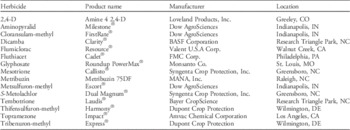
Data collection in the mother plant production year included visual estimation of potato foliar injury and tuber yield and quality. Foliar injury was estimated on a scale of 0% to 100%, where 100% represents plant death. Tubers were harvested at crop maturity from one of the two center rows of each plot and graded according to US Department of Agriculture Agricultural Marketing Service standards (USDA-AMS 2013). Tuber specific gravity, a measure of tuber density that reflects potato processing quality, was determined using the water displacement method described by Dean and Thornton (Reference Dean and Thornton1992). Data collection in the daughter plant year included the same parameters as described for the mother plant production year, plus stand density and affected plant incidence. The additional parameters were evaluated by counting the number of emerged plants and the number of injured plants in the rows that would be harvested. Data were subjected to ANOVA to determine if there was a year-by-variety interaction using PROC GLM in Statistical Analysis Software (SAS Institute Inc., Cary, NC 27513). An interaction was observed, and therefore data were analyzed and presented by crop and year. Means were separated using Fisher’s LSD at P=0.05.
Results and Discussion
Mother Potato Plant Growth
Potato foliar injury was 10% by 5 d after treatment (DAT) where mesotrione was applied, and remained in that range through 20 DAT. Injury consisted primarily of bleached and stunted new foliage. Dicamba injury was 17% by 13 DAT, and remained high through the 29-d evaluation period. Similar injury severity was observed where aminopyralid was applied. Symptomology for both herbicides consisted of severely cupped leaves at the meristematic stem ends. Mother potato plant foliar injury was 5% or less in all other treatments (Table 2). A higher incidence of injury was observed in 2014 than in 2013. We hypothesize that this may be due to environmental conditions near the time of herbicide application in 2014 that favored uptake and translocation, combined with subtle differences in the transition in sinks from the vegetative foliage to the initiating tubers among individual potato plants. Foliar injury patterns from dicamba and aminopyralid in 2014 were similar to those in 2013, with minimal early injury followed by 12% to 17% injury 12 DAT that persisted for the remainder of the 28-d evaluation period. Injury from mesotrione 4 DAT was 11%, but dissipated to 1% by 28 DAT. In contrast to 2013, potato plant injury caused by the acetolactate synthase–inhibiting herbicides cloransulam-methyl, tribenuron-methyl, and metsulfuron-methyl was 10% or more at all evaluation times and was as high as 34% in some cases (Table 3).
Table 2 Visual estimation of mother potato plant foliar injury in 2013 in Hancock, Wisconsin.
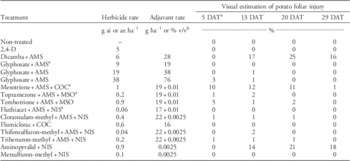
a Abbreviations: AMS, ammonium sulfate; COC, crop oil concentrate; DAT, d after treatment; MSO, methylated seed oil; NIS, non-ionic surfactant.
b AMS rates are in g ha−1. COC, MSO, and NIS rates are in % v/v.
Table 3 Visual estimation of mother potato plant foliar injury in 2014 in Hancock, Wisconsin.
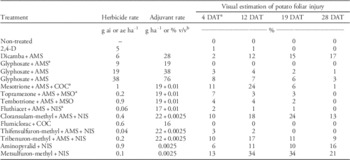
a Abbreviations: AMS, ammonium sulfate; COC, crop oil concentrate; DAT, d after treatment; MSO, methylated seed oil; NIS, non-ionic surfactant.
b AMS rates are in g ha−1. COC, MSO, and NIS rates are in % v/v.
Mother Potato Plant Yield
In 2013, minimal crop injury resulted in no differences in yield between the non-treated potato plants and the potato plants receiving herbicide treatments. Even where potato plant foliar injury from dicamba and aminopyralid persisted 29 DAT, no impact on potato yield or quality (assessed by cull tuber yield) was observed relative to non-treated potato plants (Table 4). In general, much greater yield response to herbicides was observed in 2014 compared to 2013. For example, in 2014 all herbicide treatments except topramezone reduced the yield of tubers weighing 113 to 169 g compared to non-treated potato plants. The yield of cull tubers, those malformed or blemished beyond marketability, was greatest among potato plants treated with cloransulam-methyl, thifensulfuron methyl, tribenuron-methyl, or metsulfuron-methyl. Where tribenuron-methyl was applied, the cull yield was almost as high as the Wisconsin state average total marketable yield for the 2014 production year (about 48,000 kg ha−1) (USDA-NASS 2015). The yield of tubers in the largest grade categories was lowest where tribenuron-methyl and metsulfuron-methyl were applied, with no tubers weighing more than 454 g and reduced yield in the 283 to 368 g weight category compared to the yield of the non-treated potato plants. Total tuber yield from the plants treated with these two herbicides was also reduced compared to the yield of the non-treated potato plants (Table 5).
Table 4 Mother potato plant tuber yield in 2013 in Hancock, Wisconsin.
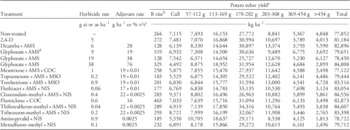
a Means within columns followed by the same letter are not significantly different according to Fisher’s protected LSD test at P≤0.05. No significant differences within a column were observed when no letters are included.
b B size potatoes include those with a diameter of 4.4 cm or less.
c AMS rates are in g ha−1. COC, MSO, and NIS rates are in % v/v.
d Abbreviations: AMS, ammonium sulfate; COC, crop oil concentrate; MSO, methylated seed oil; NIS, non-ionic surfactant.
Table 5 Mother potato plant tuber yield in 2014 in Hancock, Wisconsin.
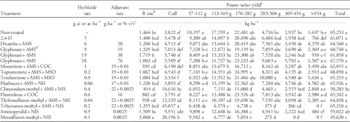
a Means within columns followed by the same letter are not significantly different according to Fisher’s protected LSD test at P≤0.05. No significant differences within a column were observed when no letters are included.
b B size potatoes include those with a diameter of 4.4 cm or less.
c AMS rates are in g ha−1. COC, MSO, and NIS rates are in % v/v.
d Abbreviations: AMS, ammonium sulfate; COC, crop oil concentrate; MSO, methylated seed oil; NIS, non-ionic surfactant.
Daughter Potato Plant Growth
Tubers from the mother plants that were exposed to the herbicide treatments were planted as seed in the following season, and the daughter plants were monitored for evidence of herbicide injury and harvested to evaluate tuber yield and quality. In 2014, for the daughter plants grown from the 2013 mother plants, stand density and the number of plants expressing herbicide symptoms in all herbicide treatment groups was similar to that of the non-treated group. Visual estimations of potato foliar injury were 10% or 11% 42 d after planting (DAP) where dicamba, glyphosate at the lowest application rate, fluthiacet, or aminopyralid were applied to the mother plants in 2013. All other visual observations of potato foliar injury were lower than 10%, and injury was minimal in all herbicide treatments by 48 DAP (Table 6). The severity of herbicide injury and negative effect on tuber yield and quality observed in the mother plant study in 2014 persisted into the 2015 daughter plant study for several treatment groups. Stand density at 35 and 43 DAP was reduced where plants were treated with aminopyralid compared to the non-treated plots. The number of potato plants expressing herbicide symptomology 49 DAP was greater than 50% of the planted crop density in glyphosate (lowest rate) or aminopyralid treatment plots. Visual estimation of crop injury 43 DAP was 10% or greater where glyphosate was applied at the two highest rates and where mesotrione or metsulfuron-methyl was applied, and 50% or greater where dicamba or aminopyralid was applied. Injury from dicamba, glyphosate at the highest rate, and aminopyralid persisted 49 DAP and ranged from 30% to 54% (Table 7).
Table 6 Daughter potato plant stand density, number of affected plants and visual estimation of foliar injury in 2014, the year after herbicide exposure, in Hancock, Wisconsin.
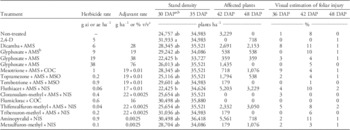
a Stand density and affected plant means within columns followed by the same letter are not significantly different according to Fisher’s protected LSD test at P≤0.05. No significant differences within a column were observed when no letters are included.
b Abbreviations: AMS, ammonium sulfate; COC, crop oil concentrate; DAP, d after planting; MSO, methylated seed oil; NIS, non-ionic surfactant.
c AMS rates are in g ha−1. COC, MSO, and NIS rates are in % v/v.
Table 7 Daughter potato plant stand density, number of affected plants and visual estimation of foliar injury in 2015, the year after herbicide exposure, in Hancock, Wisconsin.
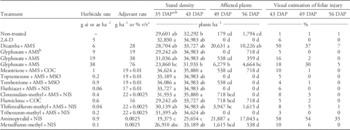
a Stand density and affected plant means within columns followed by the same letter are not significantly different according to Fisher’s protected LSD test at P≤0.05. No significant differences within a column were observed when no letters are included.
b Abbreviations: AMS, ammonium sulfate; DAP, d after planting; COC, crop oil concentrate; MSO, methylated seed oil; NIS, non-ionic surfactant.
c AMS rates are in g ha−1. COC, MSO, and NIS rates are in % v/v.
Daughter Potato Plant Yield
Potato seed planted in 2014 from the 2013 mother plant study exhibited minimal injury, and stand density was similar for the treated and non-treated potato plants. As a result, tuber yield and quality in the 2014 harvest was similar among all herbicide treatments and between the treatments and the non-treated check (Table 8). In 2015, however, some of the herbicides that had caused injury in the 2014 mother plants also reduced yield in the 2015 daughter crop. Tuber quality, indicated by the cull weight, did not differ among treatments or between treatments and the non-treated check. Glyphosate applied at the lowest rate increased tuber yield in the 57 to 112 g weight category. Injury from aminopyralid reduced the yield of the two lightest grade weight categories, and as a result reduced the total tuber yield compared to the non-treated check. Additionally, metsulfuron-methyl reduced tuber yield in the 113 to 169 g weight category compared the non-treated check. All other weight categories and total tuber yield were similar between herbicide-treated potato plants and the non-treated plants (Table 9).
Table 8 Daughter potato plant tuber yield in 2014, the year after herbicide exposure, in Hancock, Wisconsin.
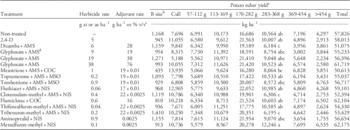
a Means within columns followed by the same letter are not significantly different according to Fisher’s protected LSD test at P≤0.05. No significant differences within a column were observed when no letters are included.
b B size potatoes include those with a diameter of 4.4 cm or less.
c AMS rates are in g ha−1. COC, MSO, and NIS rates are in % v/v.
d Abbreviations: AMS, ammonium sulfate; COC, crop oil concentrate; MSO, methylated seed oil; NIS, non-ionic surfactant.
Table 9 Daughter potato plant tuber yield in 2015, the year after herbicide exposure, in Hancock, Wisconsin.
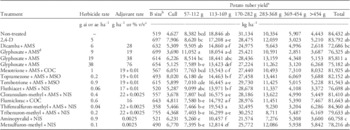
a Means within columns followed by the same letter are not significantly different according to Fisher’s protected LSD test at P≤0.05. No significant differences within a column were observed when no letters are included.
b B size potatoes include those with a diameter of 4.4 cm or less.
c AMS rates are in g ha−1. COC, MSO, and NIS rates are in % v/v.
d Abbreviations: AMS, ammonium sulfate; COC, crop oil concentrate; MSO, methylated seed oil; NIS, non-ionic surfactant.
The variability among production years in potato response and daughter tuber injury documented by Wall (Reference Wall1994) for the herbicides clopyralid, tribenuron, and dicamba was similar to what was observed in this study with a broader array of herbicide active ingredients. The lack of consistency in the connection between visual injury in the mother potato plant and affected daughter tuber growth and yield in the following year challenges traditional crop scouting as a tool to assess off-target herbicide risk. While somewhat variable, these results document that seed potato crops are at risk if off-target herbicide exposure does occur. Our current research is focused on non-visual measurement of potato injury, such as through spectral image sensing, that could be used in greenhouse assays during the time period between the mother plant seed production year and the following daughter tuber field season to predict risk of herbicide-induced growth issues.











